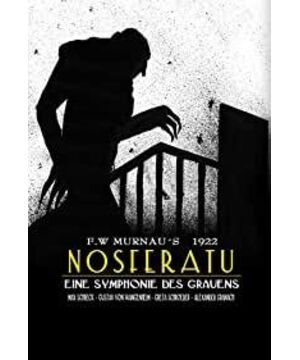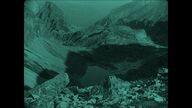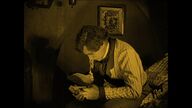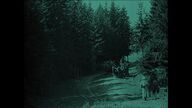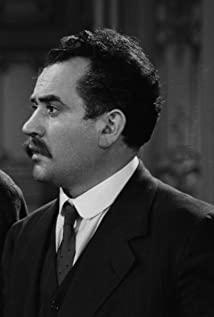As one of the most famous vampire-themed films, "Nosferatu" has been labeled with many labels. Indeed, it is indeed the first vampire-themed film and a representative of expressionist films. It has created an indelible classic screen image. However, Murnau's ambitions are far more than that. This film is more like a doctoral dissertation, a pioneer to break through to a higher and broader unknown field.
As we all know, Murnau is one of the Three Musketeers of German silent films, and the most dazzling German in the 1920s and the most significant contribution to the world’s films were "expressionist" films. When it comes to expressionist films, what is unavoidable is the milestone of expressionist films, the originator of thrillers, and the pioneer of films that explore mental issues-"Dr. Caligari's Cabin" (1920). As a movie of the Weimar Republic in 1920, its shooting method, story structure, suspense setting and unfolding, and the performance of the actors are still very contagious today. It is considered to be the purest and most perfect embodiment of the creed of expressionism, "film must be a painting that can bring life", has already demonstrated the charm of expressionism film to a peak from the beginning of the birth of expressionism film. . Facing the jewels of "Dr. Caligari's Cabin" ahead, does Murnau just want to follow in his footsteps and create an image of a vampire? Judging from the shooting technique and logic, it is far from that simple.
In order to highlight the effect of expressionism, "Dr. Caligari's Cabin" uses all set-up shots and a large number of painted backgrounds to fully express the subjective feelings of distortion and craziness. And "Nosferatu" uses a lot of location and real-life shooting, using scene selection and photography skills to enhance the appeal. Mornau chose desolate castles, Gothic buildings, winding and narrow streets, and quirky-shaped trees in the exterior scenes to create a set effect in the studio. At the same time, it adopted fast motion, negative images, overprinting and pause shooting (Merieux). The usual movie magic techniques) and the huge black shadows of vampires formed by lighting techniques, interweave the scenes in real life into a nightmare that transcends reality. The reason for the technical approach is that through the shooting of real scenes, the film greatly broadens the space of the scene, and at the same time greatly expands the scope of the subject of the film. This is what "Nosferatu" took on the expressionist film. A big step.
Seeing such an arrangement, looking at the movie itself on the contrary, one can find a deeper level of discovery from the logic of his expression. The movie tells the story of a real estate agent who asked a young employee Hart to go to an off-travel castle to make a real estate business. During Hart’s stay in the castle, he discovered that the owner of the castle, Earl Nosferatu, was a vampire, and at the same time, Noss Ferratto also accidentally saw the photo of Hart's young and beautiful wife, Allen, and was deeply attracted by it. Nosferatu quickly signed a real estate agreement and took a boat to the town to collect the house. Hart also tried his best to escape the castle and return to the town. With the arrival of Nosferatu, the town was not immune to the plague along the way. In the end, the pure and beautiful Allen eliminated Nosferatu according to the method in the book and sacrificed himself. From the perspective of the storyline told, it is much larger than the scene space of "Dr. Caligari's Cabin", which is considered a big production, and at the same time it has greater ambitions in the discussion of the theme. As an expressionist film and a horror-themed film, Mornau did not focus on how to make the storyline more attractive, nor did he put great effort into highlighting such a classic and scary character image. In the process of telling the story, the method of flat and straightforward narration was basically adopted. The first-person bystander perspective was used in the caption card to reveal the fact that Hart did not die in the end, which greatly weakened the horror suspense of the film. The parallel and cross-editing in the film is only for the narrative needs of different timelines, not to enhance the tense rhythm of the film like Griffith. In Nosferatu’s performance, he rarely uses macro close-ups—the few macro close-ups are subjective close-up perspectives—but more use of mid-range or even distant shots for performance, which also weakens Noss. The horror effect of the image of Feratu. From this point of view, Murnau's pursuit in this film is not only to create a terrifying image, and to use expressionist techniques to create a fearful subjective feeling, but to have a theme he cares more about.
Compared with narrative skills and performance skills, Mornau is more concerned about the narrative logic of the film. What is a vampire, where do vampires come from, and how do vampires overcome. From the description of the film, it can be understood that vampires are the offspring of Satan and the incarnation of evil. The vampire "Nosferatu" means plague (so he carries a lot of rats with him), and the largest plague in Europe in history is -The Black Death. The outbreak of the Black Death was introduced by the Mongols attacking Europe. The terrible plague quickly swept across Europe, causing more than 40 million deaths in Europe. In the face of the sudden plague, people cannot explain it, let alone treat it. In order to seek sustenance, people came to the church hoping to receive the protection and comfort of the gods, but there was no effect, which greatly shaken people's belief in religion and God, thus kicking off the European Renaissance and the rise of science. In the film, although vampires set foot on the cargo ship town at a precarious time, Murnau still asked the botanist to tell the students about the knowledge of carnivorous plants and explain the spread of tiny plants that barely exist in appearance. It is trying to explain the spread of the plague in a scientific way to reflect the intelligibility of Nosferatu. At the same time, the film spends a lot of time reviewing the descriptive sentences in religious books in an extremely compact rhythm, revealing that the punishment of evil comes from original sin, and the way to overcome evil is self-sacrifice. The final conclusion is that the plague comes from evil, and victory over evil requires religious sacrifice. This theme changed history. The Black Death had overthrown belief in religion and triggered humanism and scientism. Mornau adopted the best of both worlds in this film. On the one hand, he recognizes the ability of science to know the world, and at the same time, he wants to preserve the salvation status of religion to humans, thereby forming a harmonious coexistence of mankind, science, and religion.
The film was released in 1922, the era of the rise of German expressionist avant-garde films. The German avant-garde films were born in the 1920s when the First World War just ended. War destroys everything like a plague. Material civilization, traditional morality, value system and belief system collapse in the war. In this environment, the forefront of artistic thought shows hopelessness of fear, negativity, decadence, depression, and manic escape. Generally speaking, the expressionist avant-garde uses a purely artistic path to express protests against the status quo. At the same time, it greatly enriches the imagination of film art and the creative power of film language in a space that strengthens self-expression and subjective feelings. A new renaissance breaks the traditional narrative of film and drama, and pushes the exploration of film non-narrative to the limit.
Although Mornau’s "Nosferatu" is the first work of the vampire genre, it created the first image of a vampire in film history and has amazing expressiveness, but Mornau is probably only based on the subject matter of vampires. As an introduction, he extended his tentacles to the discussion on the topic of the relationship between post-war life and religion, which aroused in-depth thinking and gave his own reference answer. This process is particularly like writing an essay on religion through film expression. For example, the essay films of French left-bank directors Chris Marc and Alan Renai, who are particularly good at this many years later, use pure images and narration to explain any abstract point of view, and completely abandon the narrative but have a strong appeal.
Interpreted in this way, "Nosferatu" has a prominent position in the film history, not only because it is the first vampire film, but because it can further expand its territory in the peak of expressionism, and actively explore more. With rich film language, he is also actively exploring the expressive ability of film art on human thought, philosophy and religious topics. At the same time, I can feel that Murnau is a movie genius who has surpassed the era at the time but can also take into account the commercial influence, and he is worthy of the reputation of a master.
View more about Nosferatu reviews


